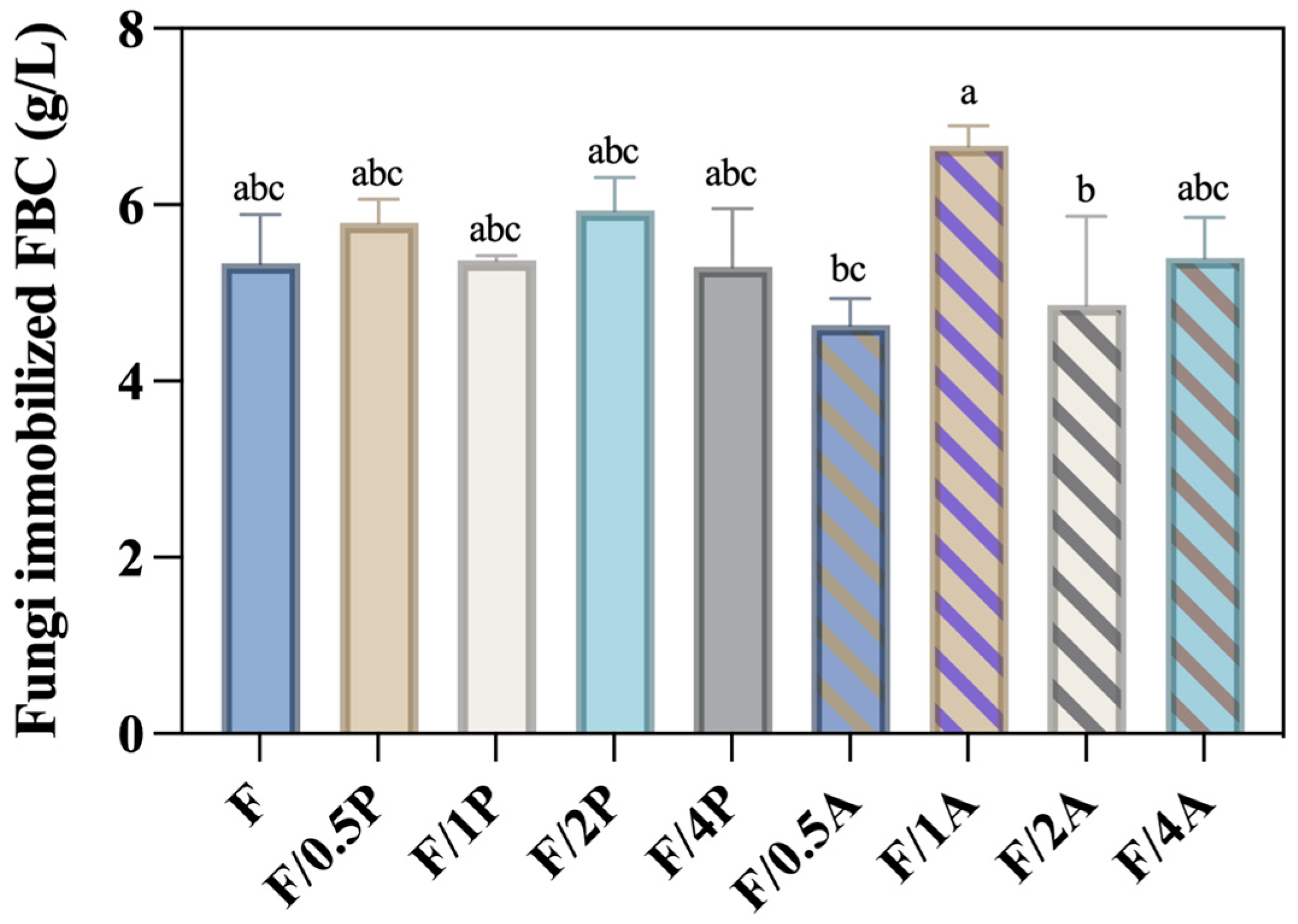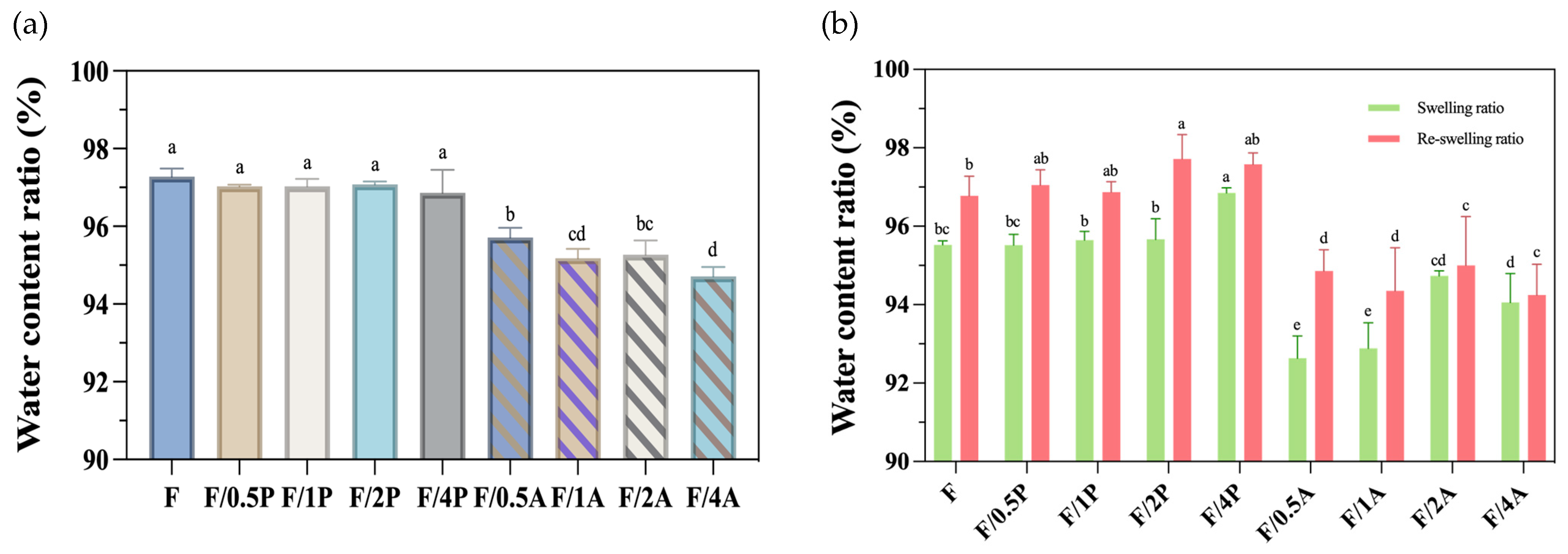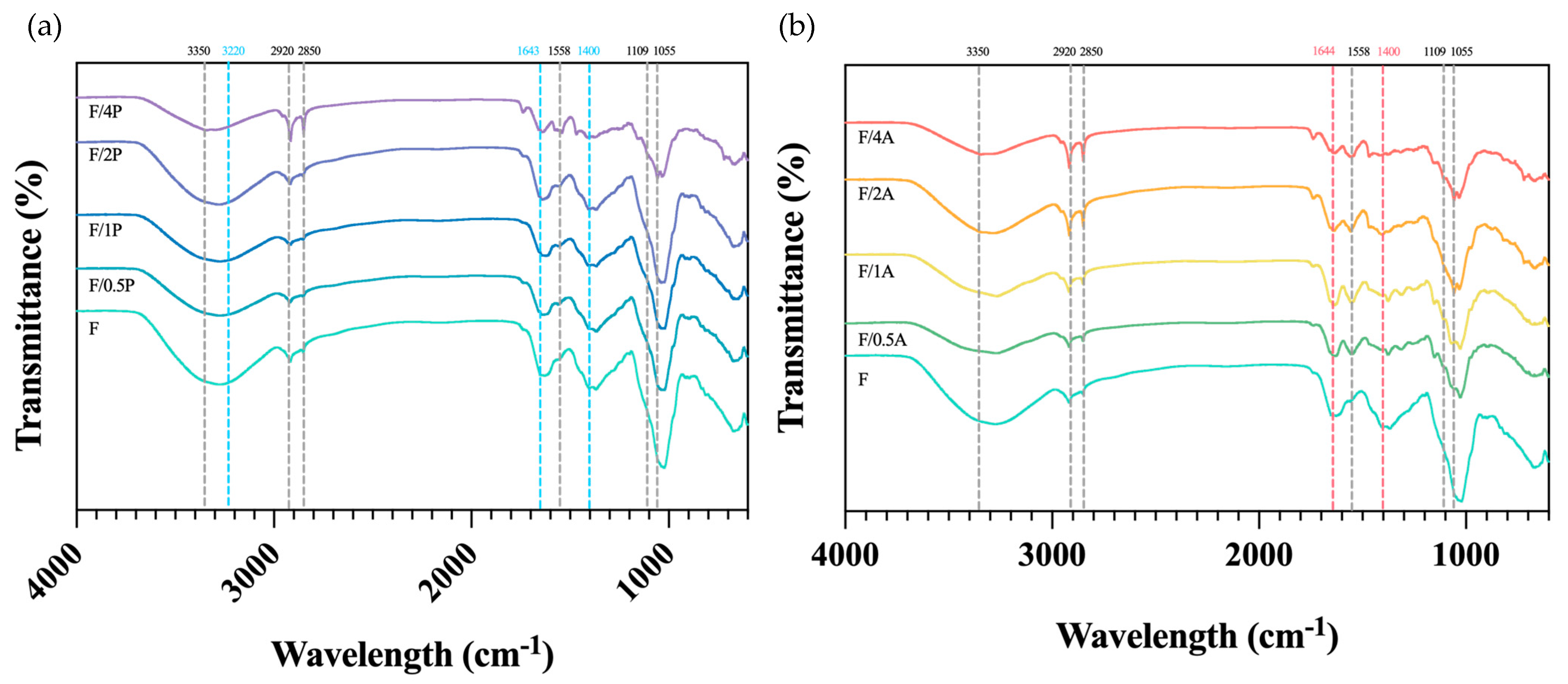Optimized Microbial Scaffolds Immobilized with Pleurotus ostreatus and Aspergillus oryzae on Foaming Bacterial Cellulose
Abstract
1. Introduction
2. Materials and Methods
2.1. Materials
2.2. Preparation of the Culture Strain
2.3. Production of FBC
2.4. Immobilization of Fungi on FBC
2.5. Physicochemical Characterization of FBC
2.5.1. Water Content and Swelling Behavior
2.5.2. Morphological Analysis
2.5.3. Fourier-Transform Infrared (FTIR) Spectroscopy
2.5.4. Thermogravimetric Analysis (TGA)
2.6. Statistical Analysis
3. Results and Discussion
3.1. Production of Fungus-Immobilized FBC
3.2. Water Content and Swelling Behavior of Fungus-Immobilized FBC
3.3. Morphological Analysis of Fungus-Immobilized FBC
3.4. Characteristic Analysis of FBC
4. Conclusions
Author Contributions
Funding
Institutional Review Board Statement
Informed Consent Statement
Data Availability Statement
Conflicts of Interest
Abbreviations
| BC | Bacterial cellulose |
| FBC | Foamed bacterial cellulose |
| FTIR | Fourier-transform infrared spectroscopy |
| SEM | Scanning electron microscopy |
| TGA | Thermogravimetric analysis |
References
- Lin, S.-P.; Calvar, I.L.; Catchmark, J.M.; Liu, J.-R.; Demirci, A.; Cheng, K.-C. Biosynthesis, production and applications of bacterial cellulose. Cellulose 2013, 20, 2191–2219. [Google Scholar] [CrossRef]
- Choi, S.M.; Rao, K.M.; Zo, S.M.; Shin, E.J.; Han, S.S. Bacterial cellulose and its applications. Polymers 2022, 14, 1080. [Google Scholar] [CrossRef] [PubMed]
- Rahman, S.S.A.; Vaishnavi, T.; Vidyasri, G.S.; Sathya, K.; Priyanka, P.; Venkatachalam, P.; Karuppiah, S. Production of bacterial cellulose using Gluconacetobacter kombuchae immobilized on Luffa aegyptiaca support. Sci. Rep. 2021, 11, 2912. [Google Scholar] [CrossRef] [PubMed]
- Ul-Islam, M.; Ullah, M.W.; Khan, S.; Park, J.K. Production of bacterial cellulose from alternative cheap and waste resources: A step for cost reduction with positive environmental aspects. Korean J. Chem. Eng. 2020, 37, 925–937. [Google Scholar] [CrossRef]
- Lin, S.-P.; Liu, C.T.; Hsu, K.D.; Hung, Y.T.; Shih, T.Y.; Cheng, K.C. Production of bacterial cellulose with various additives in a PCS rotating disk bioreactor and its material property analysis. Cellulose 2016, 23, 367–377. [Google Scholar] [CrossRef]
- Sulaeva, I.; Hettegger, H.; Bergen, A.; Rohrer, C.; Kostic, M.; Konnerth, J.; Rosenau, T.; Potthast, A. Fabrication of bacterial cellulose-based wound dressings with improved performance by impregnation with alginate. Mater. Sci. Eng. C 2020, 110, 110619. [Google Scholar] [CrossRef]
- Kumaravel, A.; Lin, S.P.; Santoso, S.P.; Shanmugasundaram, S.; Hsu, H.Y.; Hsieh, C.W.; Chou, C.W.; Lin, H.W.; Cheng, K.C. Unlocking the potential of bacterial cellulose: Synthesis, functionalization, and industrial impact. Int. J. Biol. Macromol. 2025, 311, 143951. [Google Scholar] [CrossRef]
- Girard, V.-D.; Chaussé, J.; Vermette, P. Bacterial cellulose: A comprehensive review. J. Appl. Polym. Sci. 2024, 141, e55163. [Google Scholar] [CrossRef]
- Svensson, A.; Nicklasson, E.; Harrah, T.; Panilaitis, B.; Kaplan, D.L.; Brittberg, M.; Gatenholm, P. Bacterial cellulose as a potential scaffold for tissue engineering of cartilage. Biomaterials 2005, 26, 419–431. [Google Scholar] [CrossRef]
- Ullah, M.W.; Manan, S.; Kiprono, S.J.; Ul-Islam, M.; Yang, G. Synthesis, structure, and properties of bacterial cellulose. In Nanocellulose: From Fundamentals to Advanced Materials; Dufresne, A., Thomas, S., Pothan, L.A., Eds.; Wiley-VCH: Weinheim, Germany, 2019; pp. 81–113. [Google Scholar]
- Rühs, P.A.; Storz, F.; López Gómez, Y.A.; Haug, M.; Fischer, P. 3D bacterial cellulose biofilms formed by foam templating. npj Biofilms Microbiomes 2018, 4, 21. [Google Scholar] [CrossRef]
- Li, H.; Cheng, F.; Li, W.; Cao, X.; Wang, Z.; Wang, M.; Robledo-Lara, J.A.; Liao, J.; Chávez-Madero, C.; Hassan, S. Expanding sacrificially printed microfluidic channel-embedded paper devices for construction of volumetric tissue models In Vitro. Biofabrication 2020, 12, 45027. [Google Scholar] [CrossRef] [PubMed]
- Yin, N.; Chen, S.; Li, Z.; Ouyang, Y.; Hu, W.; Tang, L.; Zhang, W.; Zhou, B.; Yang, J.; Xu, Q.; et al. Porous bacterial cellulose prepared by a facile surfactant-assisted foaming method in azodicarbonamide-NaOH aqueous solution. Mater. Lett. 2012, 81, 131–134. [Google Scholar] [CrossRef]
- Lin, S.-P.; Hong, L.; Hsieh, C.-C.; Lin, Y.-H.; Chou, Y.-C.; Santoso, S.P.; Hsieh, C.-W.; Tsai, T.-Y.; Cheng, K.-C. In Situ modification of foaming bacterial cellulose with chitosan and its application to active food packaging. Int. J. Biol. Macromol. 2024, 279, 135114. [Google Scholar] [CrossRef]
- Wang, P.; Zhao, J.; Xuan, R.; Wang, Y.; Zou, C.; Zhang, Z.; Wan, Y.; Xu, Y. Flexible and monolithic zinc oxide bionanocomposite foams by a bacterial cellulose mediated approach for antibacterial applications. Dalton Trans. 2014, 43, 6762–6768. [Google Scholar] [CrossRef]
- Li, G.; Wang, Y.; Yu, D.; Zhu, P.; Zhao, G.; Liu, C.; Zhao, H. Ligninolytic characteristics of Pleurotus ostreatus cultivated in cotton stalk media. Front. Microbiol. 2022, 13, 1035040. [Google Scholar] [CrossRef]
- Zhuo, R.; Fan, F. A comprehensive insight into the application of white rot fungi and their lignocellulolytic enzymes in the removal of organic pollutants. Sci. Total Environ. 2021, 778, 146132. [Google Scholar] [CrossRef]
- Shinkawa, S.; Mitsuzawa, S. Feasibility study of on-site solid-state enzyme production by Aspergillus oryzae. Biotechnol. Biofuels 2020, 13, 31. [Google Scholar] [CrossRef]
- Lu, J.; Li, R.; Chang, Y.; Zhang, Y.; Zhang, N.; Tao, L.; Xu, W. Effects of different parameters on the removal of atrazine in a water environment by Aspergillus oryzae biosorption. J. Pestic. Sci. 2021, 46, 214–221. [Google Scholar] [CrossRef] [PubMed]
- Sun, Z.; Wu, Y.; Long, S.; Feng, S.; Jia, X.; Hu, Y.; Ma, M.; Liu, J.; Zeng, B. Aspergillus oryzae as a cell factory: Research and applications in Industrial Production. J. Fungi 2024, 10, 248. [Google Scholar] [CrossRef]
- Wu, Y.-N.; Su, D.; Yang, J.; Yi, Y.; Wang, A.-D.; Yang, M.; Li, J.-L.; Fan, B.-Y.; Chen, G.-T.; Wang, W.-L. Biotransformation of ursonic acid by Aspergillus ochraceus and Aspergillus oryzae to discover anti-neuroinflammatory derivatives. Molecules 2023, 28, 7943. [Google Scholar] [CrossRef]
- de Castro, K.C.; Leme, V.F.C.; Souza, F.H.M.; Costa, G.O.B.; Santos, G.E.; Litordi, L.R.V.; Andrade, G.S.S. Performance of inactivated Aspergillus oryzae cells on dye removal in aqueous solutions. Environ. Technol. Innov. 2021, 24, 101828. [Google Scholar] [CrossRef]
- Nie, Y.; Wang, Z.; Zhang, R.; Ma, J.; Zhang, H.; Li, S.; Li, J. Aspergillus oryzae, a novel eco-friendly fungal bioflocculant for turbid drinking water treatment. Sep. Purif. Technol. 2021, 279, 119669. [Google Scholar] [CrossRef]
- Lin, S.-P.; Singajaya, S.; Lo, T.-Y.; Santoso, S.P.; Hsu, H.-Y.; Cheng, K.-C. Evaluation of porous bacterial cellulose produced from foam templating with different additives and its application in 3D cell culture. Int. J. Biol. Macromol. 2023, 234, 123680. [Google Scholar] [CrossRef] [PubMed]
- Kusuma, A.C.; Chou, Y.-C.; Hsieh, C.-C.; Santoso, S.P.; Go, A.W.; Lin, H.-T.V.; Hsiao, I.-L.; Lin, S.-P. Agar-altered foaming bacterial cellulose with carvacrol for active food packaging applications. Food Packag. Shelf Life 2024, 42, 101269. [Google Scholar] [CrossRef]
- Zywicka, A.; Wenelska, K.; Junka, A.; Chodaczek, G.; Szymczyk, P.; Fijalkowski, K. Immobilization pattern of morphologically different microorganisms on bacterial cellulose membranes. World J. Microbiol. Biotechnol. 2019, 35, 11. [Google Scholar] [CrossRef] [PubMed]
- George, J.; Ramana, K.; Bawa, A.S. Bacterial cellulose nanocrystals exhibiting high thermal stability and their polymer nanocomposites. Int. J. Biol. Macromol. 2011, 48, 50–57. [Google Scholar] [CrossRef]
- Bekiaris, G.; Tagkouli, D.; Koutrotsios, G.; Kalogeropoulos, N.; Zervakis, G.I. Pleurotus mushrooms content in glucans and ergosterol assessed by ATR-FTIR spectroscopy and multivariate analysis. Foods 2020, 9, 535. [Google Scholar] [CrossRef]
- Oliveira, R.N.; Mancini, M.C.; de Oliveira, F.C.S.; Passos, T.M.; Quilty, B.; Thiré, R.M.D.M.; McGuinness, G.B. FTIR analysis and quantification of phenols and flavonoids of five commercially available plants extracts used in wound healing. Materia 2016, 21, 767–779. [Google Scholar] [CrossRef]






Disclaimer/Publisher’s Note: The statements, opinions and data contained in all publications are solely those of the individual author(s) and contributor(s) and not of MDPI and/or the editor(s). MDPI and/or the editor(s) disclaim responsibility for any injury to people or property resulting from any ideas, methods, instructions or products referred to in the content. |
© 2025 by the authors. Licensee MDPI, Basel, Switzerland. This article is an open access article distributed under the terms and conditions of the Creative Commons Attribution (CC BY) license (https://creativecommons.org/licenses/by/4.0/).
Share and Cite
Chan, P.-C.; Ku, W.-L.; Chuang, Y.-K.; Chou, Y.-C.; Hsieh, C.-C.; Lin, Y.-K.; Santoso, S.P.; Lin, S.-P. Optimized Microbial Scaffolds Immobilized with Pleurotus ostreatus and Aspergillus oryzae on Foaming Bacterial Cellulose. Materials 2025, 18, 3151. https://doi.org/10.3390/ma18133151
Chan P-C, Ku W-L, Chuang Y-K, Chou Y-C, Hsieh C-C, Lin Y-K, Santoso SP, Lin S-P. Optimized Microbial Scaffolds Immobilized with Pleurotus ostreatus and Aspergillus oryzae on Foaming Bacterial Cellulose. Materials. 2025; 18(13):3151. https://doi.org/10.3390/ma18133151
Chicago/Turabian StyleChan, Pei-Ching, Wei-Lun Ku, Yung-Kun Chuang, Yu-Chieh Chou, Chen-Che Hsieh, Yung-Kai Lin, Shella Permatasari Santoso, and Shin-Ping Lin. 2025. "Optimized Microbial Scaffolds Immobilized with Pleurotus ostreatus and Aspergillus oryzae on Foaming Bacterial Cellulose" Materials 18, no. 13: 3151. https://doi.org/10.3390/ma18133151
APA StyleChan, P.-C., Ku, W.-L., Chuang, Y.-K., Chou, Y.-C., Hsieh, C.-C., Lin, Y.-K., Santoso, S. P., & Lin, S.-P. (2025). Optimized Microbial Scaffolds Immobilized with Pleurotus ostreatus and Aspergillus oryzae on Foaming Bacterial Cellulose. Materials, 18(13), 3151. https://doi.org/10.3390/ma18133151








